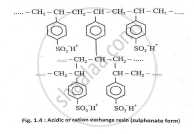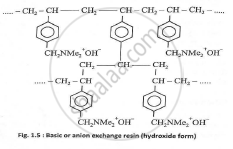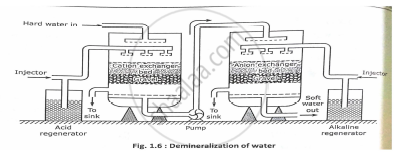Advertisements
Advertisements
Question
Explain lon-exchange process for Softening of hard water. What are its advantages and disadvantages.
Solution
Ion-exchange resins are insoluble, cross-linked, long chained organic polymer with a microporous structure. The functional groups attached to the chains are responsible for the ionexchange properties. The ion exchange resins are classified as follows:
1. Cation exchange resins
2. Anion exchange resins.
CATION EXCHANGE RESINS.
There are mainly styrene-divinyl benzene copolymers, which on sulphonation or carboxylation, become capable of exchanging their hydrogen ions with the cations in the water .

• ANION EXCHANGE RESINS.
There are styrene -divinyl benzene or amine- formaldehyde copolymers, which contain amino or quaternary ammonium or quaternary phosphonium or tertiary sulphonium groups as an integral part of the resins matrix. These are after treatment with dil. NaOH solution, become capable of exchanging theirOH-anions with anions in water .

PROCESS:
The hard water is passed first through cation exchange column which removes all the
cations like Ca2+, Mg2+ etc. from it and equivalent amount ofH+ ions are released form this
column to water,
2RH+ + Ca2+ → R2 Ca2+ + 2H+
2RH+ + Mg2+ → R2 Mg2+ + 2H+
After cation exchange column the hard water is passed through anion exchange column, which removes all the anions like `SO_4^(2-)`CI etc, present in the water and equivalent amounts ofOH-ions are released from this column to water.
R`OH- + CI → R`CI- + OH-
2R'OH- + SO-4 → R`2 `SO_4^(2-)`+ 20H-
`2ROH^- + CO_3^(2-) → R_2 CO_3^- + 2OH^-`
H+ and 0 H-ions get combined to produce water molecule. Thus the water coming out from the exchanger is free from cations as well as anions. /on-free water is known as deionized or
demineralised water.

ADVANTAGES:
1. The process can be used to soften highly acidic or alkaline water.
2. It produces water of very low hardness. So it is very good for treating water for use in
high pressure boilers.
DISADVANTAGES:
1. The equipment is costly and more expensive chemicals are needed.
2. If water contains turbidity I then the output of the process is reduced. The turbidity must be below 7 0 ppm. If it is more I it has to be removed first by coagulation and filtration.
